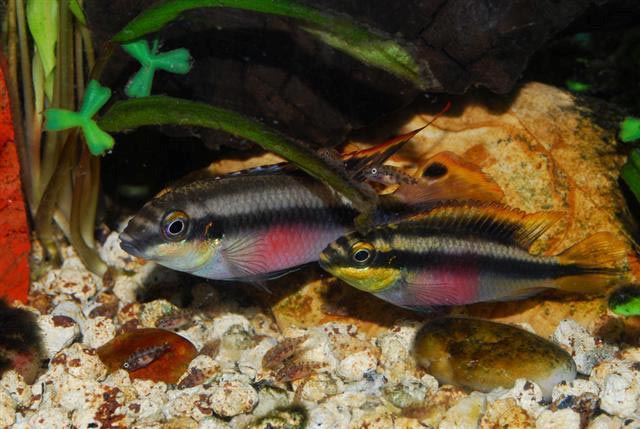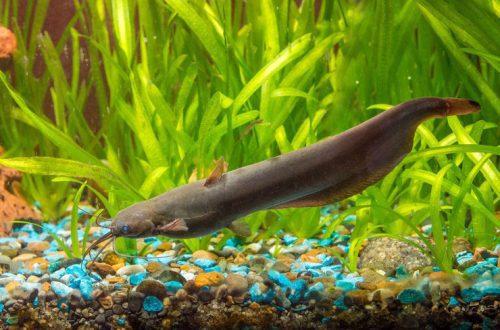
Cribensis
Kribensis or Pelvicachromis pulcher, scientific name Pelvicachromis pulcher, belongs to the Cichlidae family. Due to its bright coloration, it is also known as the Aquarium parakeet. One of the most popular aquarium fish among cichlids. For a long time it has been bred in an artificial environment, due to which it has acquired some adaptive features – a larger range of permissible water parameters and a moderate level of aggression in comparison with its wild relatives.

Habitat
distributed in the Niger River Basin on the territory of modern Nigeria and Cameroon (Africa). Inhabits slow-moving, shallow waters. Prefers areas with dense vegetation. Some populations have been found in brackish systems.
Requirements and conditions:
- The volume of the aquarium – from 70 liters.
- Temperature – 24-27°C
- Value pH — 5.0–8.0
- Water hardness – range from soft to medium hardness (5-19 dH)
- Substrate type – sand or fine gravel
- Lighting – moderate
- Brackish water – no
- Water movement – moderate, weak
- Size – 7–9 cm.
- Meals – any
Description

Not a high oblong body, dorsal and anal fins have pointed tips. The color is predominantly gray, but the abdomen has a cherry-red color, especially bright in females. A longitudinal dark stripe stretches across the entire body from the mouth to the caudal fin.
Food
Perfectly adapted to all types of dry or freeze-dried food (granules, flakes), accepts live or frozen food from bloodworms, mosquito larvae, etc. The optimal diet consists of a combination of dry and live food.
Maintenance and care
Unpretentious in content, do not require special conditions. They feel great in water of different hardness (GH) and acidity (pH) within reasonable limits. For a pair of fish, a modest-sized tank of 70 liters or more is required. In the design, it is desirable to have a large number of hiding places – potential spawning grounds, for example, in the form of decorative caves, grottoes, snags, intertwined tree roots, etc. Depending on the chosen underwater interior, earthenware jugs and pots will also come in handy. Plants are not mandatory, but they are an important part of the biological balance, so their selection is limited to your desires. Substrate of coarse sand or fine gravel.
The standard set of equipment includes a filter, a heater, an aerator and a lighting system. Good water quality is ensured by its weekly renewal by 10–15% and by cleaning the soil from organic residues (uneaten food, excrement, etc.).
Behavior
Relatively peaceful and even modest fish, but its behavior changes during spawning. During this period, Pelvicachromis pulcher becomes moderately aggressive, protecting its future offspring. Compatible with many calm fish species such as Rasbora, Danio, Gourami, Corydoras catfish and the like.
Breeding / breeding
Breeding at home is not difficult. Fish form a permanent pair, which usually persists throughout life. However, partners can be quite finicky in choosing their companion, so in order to guarantee a pair, acquire a group of 6 or more young individuals, at least one pair must be formed during the maturation process. If there is no opportunity or desire to buy so many fish, pick up the largest male and the brightest female.
The incentive for spawning is good nutrition. Meat products must be present in the diet. A sign that the female is ready to lay eggs is her color – the abdomen is painted in a rich cherry color, and also noticeably swells from the eggs. Spawning takes place in one of the shelters, in a cave, grotto. During this period, set the pH value around the neutral mark of 7.0, since the acidity of the water affects the sexual distribution in future offspring. For example, if the water is acidic, then more females appear, if alkaline, then males appear.
The female lays up to 300 eggs. The incubation period is 2-3 days, after another 7 days the fry can already swim. They stay in a flock around their parents, in time of danger they quickly hide in the female’s mouth, and the male defends. At first, the juveniles are too small to accept any food, they feed on algae and detritus, then specialized microfood for fry can be fed.
Diseases
Pelvicachromis pulcher is hardy, the main cause of the disease, as a rule, is contact with other sick fish or a significant deterioration in living conditions and food quality. Read more about symptoms and treatments in the Aquarium Fish Diseases section.





